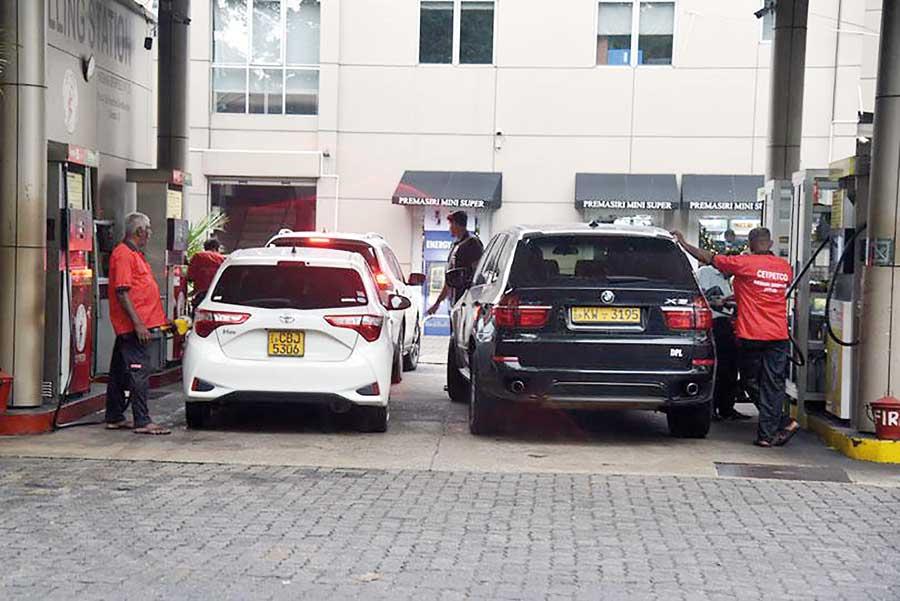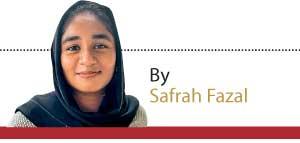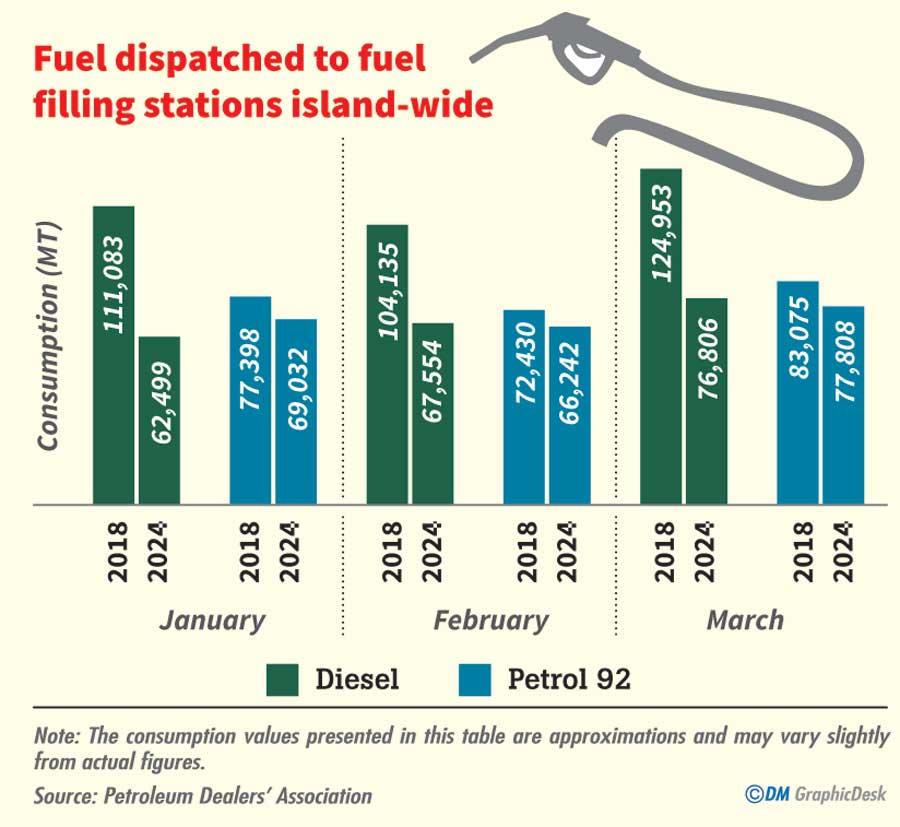10 Apr 2024 - {{hitsCtrl.values.hits}}

Media recently reported that there has been a nearly 50% reduction in fuel consumption compared to the pre-pandemic period
(Pic by Pradeep Pathirana)
- According to sources fuel consumption will witness a further decline owing to nearly 200 countries including Sri Lanka signing the Paris Agreement
- With the financial constraints that people are facing at present, many have had to prioritise food and other essentials
- Those who travelled 10,000 kilometres in their vehicles are now compelled to travel only about 5,000 kilometres
- Economic experts observe that the Sri Lankan vehicular fleet has remained somewhat stagnant as a result
Reducing fuel consumption is now a global necessity as the world shifts towards greener practices in response to climate change. Hence, while reports of 50% reduction in fuel consumption in Sri Lanka should be readily welcome, it prompts the question of whether people are now much more conscious of the environment or whether many simply cannot afford fuel. It is also said that fuel consumption serves as an economic growth indicator.
consumption in Sri Lanka should be readily welcome, it prompts the question of whether people are now much more conscious of the environment or whether many simply cannot afford fuel. It is also said that fuel consumption serves as an economic growth indicator.
Significant fuel sales drop from pre-COVID levels
Speaking to Daily Mirror, Secretary of the Petroleum Dealers’ Association, Kapila Naotunna, noted that fuel sales had not picked up from the pre-pandemic period.
Table 01 illustrates a comparison of fuel dispatched to fuel stations island-wide between January to March 2018 and January to March 2024, providing a concise overview of the fuel consumption difference. A difference of nearly 35-45% can be seen today in comparison to pre-pandemic levels.
According to Naotunna, with the financial constraints that people are facing at present, many have had to prioritise food and other essentials; leaving them with little money to purchase fuel.
“Before the pandemic and subsequent economic crisis, prices of petrol and diesel were below Rs. 200 (per litre); but today, prices of both are well-above Rs. 300. A person pumping fuel for Rs. 1,000 won’t even receive 3 Litres (L). What can a car do with 3L? Therefore, more people are opting for public transport and are limiting their outings because of high prices,” he said.
As of mid-December 2018, Auto Diesel was sold at Rs. 106 per litre, while 92 Octane Petrol was sold at Rs. 135 per litre. Today, Auto Diesel is sold at Rs. 363 per litre, while 92 Octane Petrol is sold at Rs. 371 at Ceypetco fuel filling stations.
In general, due to economic reasons, people’s income levels have not increased, but fuel prices have shot up three-fold since the pre-pandemic era. Therefore, many can no longer afford fuel, and have thereby drastically cut down their usage of vehicles. The consumption of petrol and diesel is an indication of economic development, and we know that the upward economic mobility is minimal”
-Cyril Suduwella, Former Deputy General Manager at CPC
Factors affecting drop in fuel consumption
Is the significant drop in fuel consumption due to the financial difficulties that Sri Lankans have plunged into, as many users on social media platforms have said? To understand this, Daily Mirror contacted Former Petroleum Consultant at Public Utilities Commission of Sri Lanka and Former Deputy General Manager at Ceylon Petroleum Corporation Cyril Suduwella.
According to Suduwella, the interplay of many factors has led to this situation; however, the economic situation at present, reduction in consumers’ buying power and the drastic increase in fuel prices are leading contributors to drop of fuel usage.
“In general, due to economic reasons, people’s income levels have not increased, but fuel prices have shot up three-fold since the pre-pandemic era. Therefore, many can no longer afford fuel, and have thereby drastically cut down their usage of vehicles. The consumption of petrol and diesel is an indication of economic development, and we know that the upward economic mobility is minimal.
“In addition to this, the buying power of consumers has reduced. The reduction of the buying power of consumers is directly related to the price of fuel and the cost per kilometre of travel. Those who travelled 10,000 kilometres in their vehicles are now compelled to travel only about 5,000 kilometres. Therefore, the total consumption has reduced. Some families who have many vehicles are using only a few now, while the rest are idling. Those who have luxury vehicles will have a second much more economical vehicle that they use more,” Suduwella emphasised.
Suduwella observed that the Sri Lankan vehicular fleet has remained somewhat stagnant with very few vehicles being added to the fleet, apart from commercial or state vehicles and public transportation. He added that vehicles that are added to the fleet are electric vehicles or hybrid vehicles.
Before the pandemic and subsequent economic crisis, prices of petrol and diesel were below Rs. 200 (per litre); but today, prices of both are well-above Rs. 300. A person pumping fuel for Rs. 1,000 won’t even receive 3 Litres (L). What can a car do with 3L”
- Kapila Naotunna Secretary of the Petroleum Dealers’ Association
Fuel consumption to reduce further?
According to Suduwella, fuel consumption will witness a further decline owing to nearly 200 countries including Sri Lanka signing the Paris Agreement.
In 2015, World leaders at the UN Climate Change Conference (COP21) held in Paris, reached an agreement to tackle climate change and its negative impacts. Accordingly, carbon emissions need to be reduced by 45% by 2030 and reach net-zero emissions by 2050.
Suduwella explained, “Many countries are opting for electric mobility (vehicles powered by electric vehicles) and the production (of petrol and diesel vehicles) has also decreased in many countries.”
Stating that the government has set up three power stations to run on Liquified Natural Gas (LNG), Suduwella added, “If LNG comes into effect, the consumption of fuel will further reduce as some may opt to convert their vehicles into LNG.”

24 Nov 2024 3 hours ago
24 Nov 2024 4 hours ago
24 Nov 2024 4 hours ago
23 Nov 2024 23 Nov 2024
23 Nov 2024 23 Nov 2024